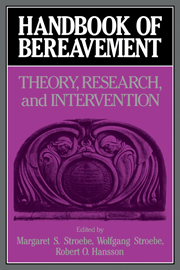Book contents
- Frontmatter
- Contents
- Contributors
- Preface
- Part I Introduction
- Part II The phenomenology and measurement of grief
- Part III Current theories of grief, mourning, and bereavement
- Part IV Physiological changes following bereavement
- Part V The psychological, social, and health impacts of conjugal bereavement
- Part VI Grief reactions to different types of loss
- 18 Loss and recovery
- 19 The death of a child is forever: The life course impact of child loss
- 20 Children's reactions to the death of a parent
- 21 Bereavement following death from AIDS: Unique problems, reactions, and special needs
- 22 Sleep and dreams in well-adjusted and less adjusted Holocaust survivors
- Part VII Coping, counseling, and therapy
- Part VIII Conclusions
- References
- Author index
- Subject Index
20 - Children's reactions to the death of a parent
Published online by Cambridge University Press: 04 May 2010
- Frontmatter
- Contents
- Contributors
- Preface
- Part I Introduction
- Part II The phenomenology and measurement of grief
- Part III Current theories of grief, mourning, and bereavement
- Part IV Physiological changes following bereavement
- Part V The psychological, social, and health impacts of conjugal bereavement
- Part VI Grief reactions to different types of loss
- 18 Loss and recovery
- 19 The death of a child is forever: The life course impact of child loss
- 20 Children's reactions to the death of a parent
- 21 Bereavement following death from AIDS: Unique problems, reactions, and special needs
- 22 Sleep and dreams in well-adjusted and less adjusted Holocaust survivors
- Part VII Coping, counseling, and therapy
- Part VIII Conclusions
- References
- Author index
- Subject Index
Summary
There is general agreement that the death of a parent for school-age children is a very stressful experience (Antonovsky, 1979; Garmezy, 1987). Some researchers have shown that such a loss can lead to depression or other behavior problems in children and also later on as adults (Furman, 1974; Birtchnell, 1980; Bowlby, 1980; Brown, Harris, & Bifulco, 1986). In contrast, other studies have not been able to point to any consistent findings supporting the hypothesis that the death of a parent in childhood leads to an increase in problem behaviors or to an increased risk of subsequently developing psychological problems (Van Eerdewegh, Bieri, Parilla, & Clayton, 1982; Osterweis, Solomon, & Green, 1984). Berlinsky and Biller (1982), in an extensive review of the research literature, observed that this lack of consistent findings may be due to an oversimplification of outcome measures, such as the presence or absence of psychiatric symptoms or other problem behaviors. Also contributing to the confusion is the use of a singleevent model, which obscures the complexity of the situation.
The death of a parent cannot be viewed as a single stressful event but as a series of events that occur before and after the death (Berlinsky & Biller, 1982; Norris & Murrell, 1987). Brown et al. (1986), in their study of depressed women who, as children, lost their mother, and Elizur and Kaffman (1983), who studied Israeli children who lost fathers in war, suggest that factors other than the loss need to be in place before a bereaved child can be considered at risk.
- Type
- Chapter
- Information
- Handbook of BereavementTheory, Research, and Intervention, pp. 300 - 316Publisher: Cambridge University PressPrint publication year: 1993
- 37
- Cited by



